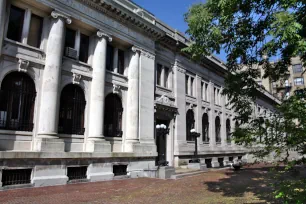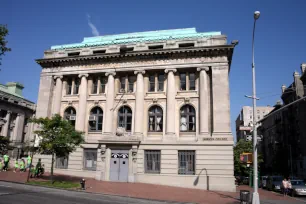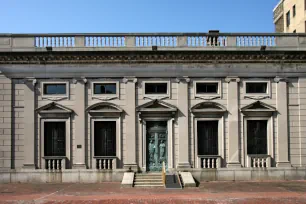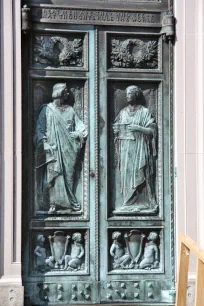Audubon Terrace is a cultural complex in Washington Heights, Manhattan. The complex was conceived in the early twentieth century by the philanthropist and Hispanophile Archer Milton Huntington.


Huntington had inherited a large fortune from his stepfather, the railroad magnate Collis Potter Huntington. Archer Huntington dedicated his life to the arts, philanthropy, and the study of the Hispanic culture.
A new Cultural Center
In 1904 Huntington founded the Hispanic Society of America. He asked his cousin Charles Pratt Huntington to design a building for the society. But Archer had bigger plans. He saw the Hispanic Society as just the first of a cluster of cultural institutions, so he asked his cousin to draw up a master plan for a cultural and research center. Archer hoped to promote collaboration between institutions by establishing them on a single site.
Huntington chose the former estate of the naturalist John James Audubon as the site for the new cultural center. The estate was located near the northern edge of the city, in what was then the rural neighborhood of Washington Heights. Huntington hoped that other institutions would follow him north to form a large cultural and educational hub.
He invited several institutions to move to Audubon Terrace, even providing funds. By 1930, when the complex was completed, six different institutions, including several specialized museums, were housed here, all of which had connections to Archer Huntington.
Buildings and Architecture


The first building opened in 1907 and housed the American Numismatic Society. It was soon followed by the Hispanic Society of America. In 1909-1912 the Spanish-language Church of Our Lady of Esperanza was built and the Museum of the American Indian joined in 1922.
All these buildings were designed by Charles P. Huntington in the same architectural style to symbolize a sense of unity and cooperation between the different institutions. Later buildings by other architects were added in the same style, a combination of Beaux-Arts and Italian Renaissance. The granite and limestone buildings are elaborately decorated with Ionic columns and pediments, reliefs and ornaments.
In 1923 the American Academy of Arts and Letters moved into a building designed by William Mitchell Kendall, of the architectural firm of McKim, Mead & White. An addition for a library and gallery was designed by Cass Gilbert and opened in 1930.

Institutions
While Archer Huntington had hoped to persuade other institutions to move to the periphery of Manhattan – where more space was available – the opposite happened: over time most cultural institutions gravitated toward Manhattan’s midtown. It turned out that the Audubon Terrace was too remotely located, and its museums suffered from low attendance.
As a result, several institutions relocated. The first to move out was the American Geographical Society, which was founded in 1858 and boasts one of the world’s largest collections of maps. In 1974 the society’s library moved to Milwaukee. Today its premises are occupied by the Boricua College, a bilingual college.


The Museum of the American Indian, now part of the Smithsonian institution, was founded in 1858. In 2004 a part of its collection moved to the National Museum of the American Indian in Washington, DC. The rest of its collection is now on display in the Custom House in downtown New York.
The American Numismatic Society, founded in 1858, has a collection of more than 600,000 objects, including coins, medals and paper money. It moved in 2008 to downtown Manhattan.
The American Academy of Arts and Letters, founded in 1898, now occupies three of Audubon Terrace’s buildings. The academy is an honor society of 250 architects, composers, artists and writers. It counted Theodore Roosevelt, Augustus Saint-Gaudens and Mark Twain among its original members. The academy exhibits art and manuscripts.
The main attraction of the Audubon terrace is the Hispanic Society of America, a free museum and reference library dedicated to the study of the Hispanic culture. Its rooms are decorated with carved paneling, majolica tiles and historic paintings. The museum has a collection of Hispanic art that includes furniture, ceramic objects, sculptures, textiles and paintings by Spanish painters including Goya, El Greco and Zurbarán. It also boasts a particularly large number of paintings by Joaquín Sorolla.

El Cid
The buildings of the Audubon Terrace are arranged around a central courtyard. At its center, in front of the main building of the Hispanic Society of America, stands a monument honoring El Cid Campeador.
The bronze statue of El Cid astride his horse was created by Anna Hyatt Huntington, wife of Archer Huntington. The Spanish hero is rousing his troops to battle. Around the pedestal are four statues of warriors. Two sculpture groups of deer complete the monumental composition.
To the left and right of the Monument to El Cid are large reliefs of Don Quixote and Boabdil. In the courtyard are also several animal sculptures, all the work of Anna Hyatt Huntington.

